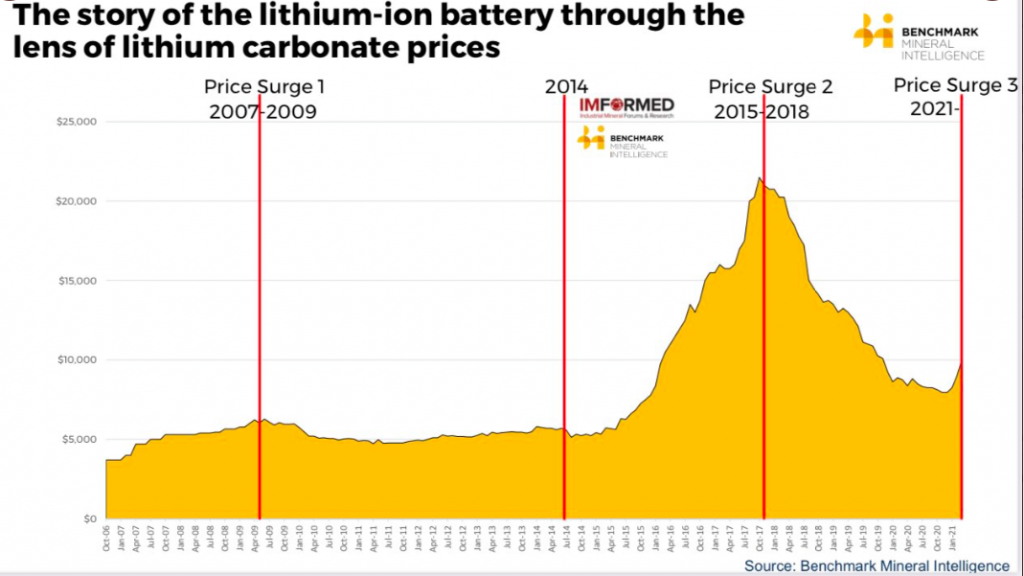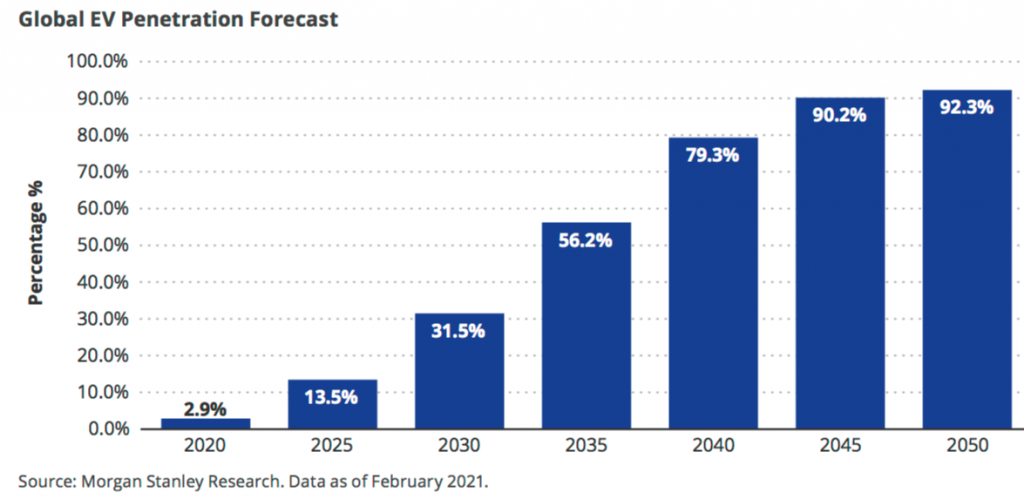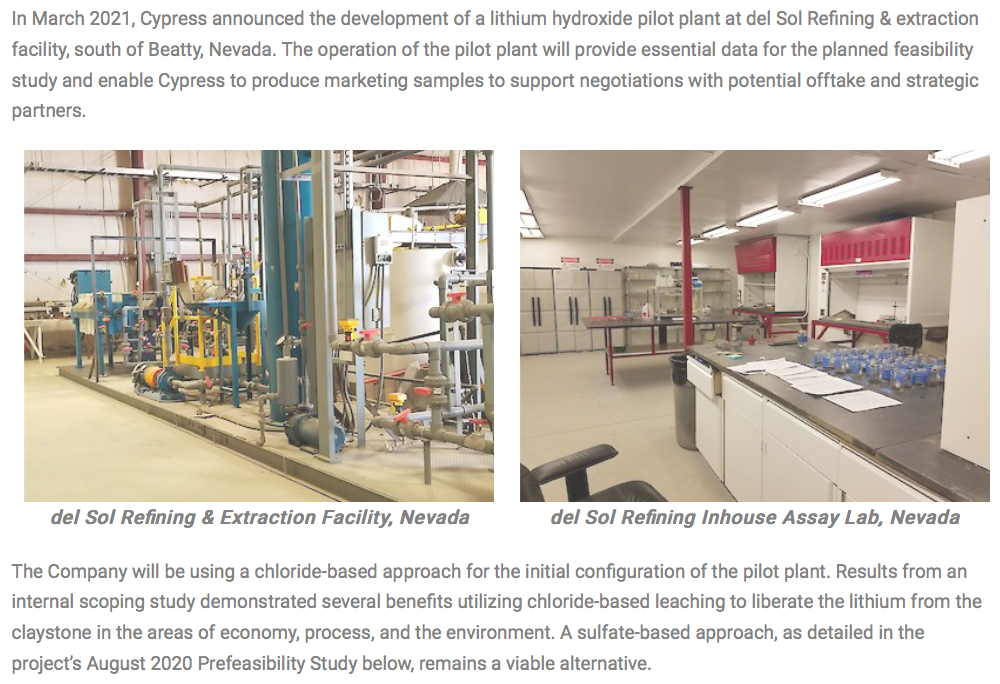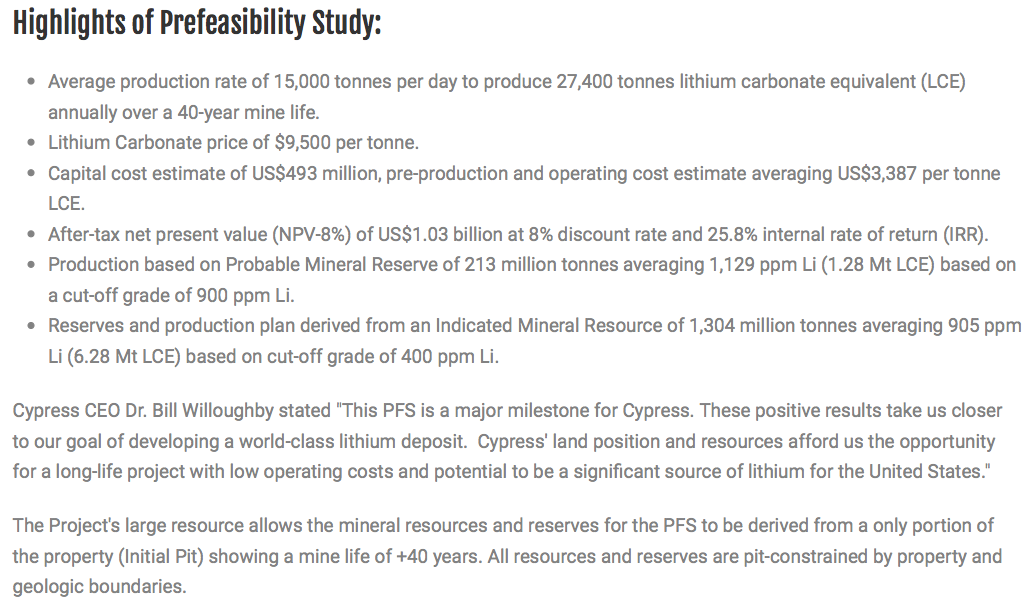In listening to & reading commentary on Lithium (“Li”) prices, analysts, journalists & management teams are quick to point to doubling in the Lithium Carbonate (“LC”) price [in China] from last year’s multi-yr. lows. While that’s certainly bullish news, prices should be viewed over a longer period than just nine months.

Benchmark Mineral Intelligence (“BMI”) recently tweeted the above chart. This indicative index of LC prices is well suited for analysis. If the dates at the bottom are too small, they begin in Oct., 2006. This weighted-average LC price index, which picks up prices from around the world, topped at ~$21.5k/Mt in late-2017, before hitting ~$8k/Mt last Summer.
Readers are reminded that before 2015-16, there was virtually no Electric Vehicle market to speak of. LC prices were ~$5k-6k/Mt in many of the years leading up to 2016 (see chart, price began a second, much larger spike in 3rd qtr. 2015). Back then, global EV penetration had only reached ~0.6% (1 out of 167 of the world’s passenger vehicles were electric).
Last year, it clocked in at a still modest 2.9%. In four years time, global EV penetration is expected to quadruple – quintuple to 12% – 15% {see chart below}. Although 2025 is very interesting, look at Morgan Stanley’s estimate for 2030 of 31.5% penetration! Note: {Global EV penetration forecasts for 2030 range from 25% to 40%}.
Earlier this year, top Li producer Albemarle Corp. increased its demand forecast for 2025 to 1.14 million Metric tonnes (“Mt”) of Lithium Carbonate Equivalent (“LCE”)/yr. Based on my observations of the Li market since early 2016, there’s no way the industry can deliver that much growth in just four years.

Yes, Li prices will be stronger for longer….
Given that 2020’s LCE demand was ~375k Mt, (estimates range from 350k to 400k Mt) even if every existing producer doubled their output, it would take 16 new [25k Mt LCE/yr. projects] to reach 1.14 million Mt/yr. Yet, there are fewer than 12 projects that propose to deliver = or > than 25k Mt LCE/yr. in the next 4-6 years.
A key takeaway — each & every project takes 1 to 4 years to ramp up to nameplate capacity, or longer if a project is developed in stages. For example, Millennial Lithium has a six-year ramp up to full battery-grade production. Galaxy Lithium’s high-grade Sal de Vida brine project in Argentina is coming online in three stages. Both projects are forecast to reach full capacity around 2028-2030.
Therefore, supply of 1.14 million Mt/yr. won’t arrive by 2025. In any event, that daunting figure pales in comparison to the anticipated need in 2030. RK Equity’s Rodney Hooper is forecasting demand of 2.9 million Mt/yr. Earlier this month, UBS increased its demand level in 2030 to 4.4 million Mt.
I strongly believe that unconventional projects (i.e. not brine or hard rock) will get funded out of sheer necessity. Several Direct Lithium Extraction (“DLE”) projects will get developed, such as Standard Lithium’s innovative brine project in Arkansas. But, we need a lot more than a handful of DLE projects.
Sedimentary deposits, such as clay-hosted mineralized zones, offer the best examples of an alternative to hard rock or brine. Globally, there are 5 or 6 large, clay-hosted Li projects (at PFS-stage or beyond) in the pipeline. Note: {No DLE or clay-hosted Li project has ever reached commercial-scale}. A few western U.S. & Mexican clay-hosted companies have projects that are pre-PEA stage.

All hands on deck; even unconventional projects desperately needed!
Where does that leave readers who want to invest in the battery metals space? I believe that one clay-hosted (sedimentary) Li junior offers a very compelling risk-reward proposition. It’s high-risk like the DLE plays, but has equal or better upside potential.
For clay-hosted Li extraction to be viable, commercial successes at Bacanora’s Sonora & Lithium Americas‘Thacker Pass projects will be critical. These two, both well-funded and slated to reach production in 2023 or 2024, will blaze a path forward for those who follow.
That’s why I remain quite bullish on Cypress Development Corp. (OTCQB: CVDVF) /(TSX-V: CYP). By standing on the shoulders of trail-blazing first movers, it will learn from their mistakes, thereby gaining the confidence of stakeholders. To be clear, Cypress is interesting in its own right, not just for riding on the coattails of Thacker Pass.
Like other sedimentary projects, Cypress has a giant Li resource (Measured & Indicated of 6.3 million Mt LC OR 7.1 million Mt Li hydroxide). The strip ratio is very low at 0.3:1.0, compared to an average of 5.6:1.0 among several other sedimentary peers.
More important, CEO Dr. Bill Willoughby, his technical team & third-party advisors believe they’ve found a better mousetrap (operating flow sheet).
As it stands, all clay-hosted Li projects, including Cypress’, plan to use sulfuric acid to liberate lithium out of host claystone into solution. However, Cypress is carefully studying the use of hydrochloric (instead of sulfuric) acid as a leaching agent. Admittedly, companies in Nevada and elsewhere have been trying to crack the clay-hosted Li code for decades.
What’s different this time? Three things. First, Cypress is greatly benefiting from expert geologic, engineering & metallurgical consultant groups, plus the considerable efforts of various Nevada state & federal agencies dating back to the 1970s.
Cypress Development Corp., at PFS-stage, well positioned in Nevada (USA)

Second, Li prices are double their long-term average, and trending higher, introducing a much needed margin for error. Third, I count 30+ publicly-listed OEMs with market caps > C$3B that are (collectively) relying on 1 million+ Mt LCE/yr., by the middle of the decade.
If Cypress can operate with hydrochloric acid it would eliminate the need to make, move & consume sulfuric acid, and there would be no need for a $102M sulfuric acid plant. Preliminary thoughts are that this new flow sheet should generate better project economics, but it’s impossible to quantify without further work.
Management believes that greater operating flexibility could potentially be achieved, allowing for the ability to produce (if warranted) more battery-grade hydroxide (per year) than contemplated in the PFS.
A new flow sheet would make the project less logistically complex and more environmentally-friendly. It would require a lot less water — although it would need more power. If Cypress could tap green-energy sources (wind / solar / geothermal), that would be really big news.
It’s no exaggeration to suggest that Cypress could have (subject to a third-party BFS/DFS) the best clay-hosted sedimentary Li project in the world, due to its uniquely favorable combination of 1] geology, 2] proximity to sustainable sources of brine and/or geothermal fluids, 3] relatively modest use of water, and 4] very low strip ratio, [0.3:1.0].
Thacker Pass clay-hosted Li project valued by analysts @ ~C$1.7 billion
Cypress is a few years behind Lithium Americas & Bacanora, but those companies will presumably pave the way forward for the Company’s eventual success. If Willoughby & his talented team can partner with an industry heavy-weight like Albemarle, then time (and technical / funding risk) to first production would be reduced.
The market is valuing Thacker Pass at ~C$1.0B. Analysts are valuing it as high as C$2.4B. If Thacker Pass is worth anywhere near the midpoint of ~C$1.7B, then Cypress is arguably worth a lot more than its paltry (fully-diluted) enterprise value of C$132M.
Assuming that Cypress has a 75% chance of success, and discounting a potential C$1.7B valuation by two-thirds (for Cypress being earlier stage on permitting & largely unfunded) — that’s still a prospective C$438M valuation.

Conclusion
I hope that readers can see that lithium demand will be strong-to-extremely strong over the next 10 years. If one agrees, one should consider buying shares in Cypress Development Corp. (OTCQB: CVDVF) /(TSX-V: CYP).
Not only is Cypress compelling as a “second” mover behind Thacker Pass & Sonora, it could have a superior flow sheet and possibly the strongest economics of any Li project on the planet, except Neo Lithium’s Tres Quebradas project in Argentina. Please see the peer comparison chart above.
Cypress has the 2nd best IRR, 2nd best EV/cap-ex ratio, 2nd best capital intensity and lowest market valuation. And, its ratio of [EV / to after-tax NPV(8%)] of just 6.6% is 84% below the peer average (42.1%) for the same ratio, of eight similar-stage Li peers.
Cashed up with ~C$22M, the PFS behind them, a pilot plant being fired up next month, water rights being negotiated and a fully-funded BFS/DFS expected in 1Q 2022 — this story has been meaningfully de-risked, (albeit, still high-risk).
As the (fewer than) 15 projects that could reach production by mid-decade begin to get tied up via off-take agreements, and as OEMs & Li producers acquire projects and/or Li juniors outright — Cypress will rise to the top of the list of investment vehicles well-suited to play the unstoppable battery metals theme.
Earlier this week, Orocobre announced a A$4 billion merger of equals with Galaxy Resources. Industry consolidation has barely begun. Obtaining security of battery metal supply will grow ever more urgent in coming years.
Disclosures / Disclaimers: The content of this article is for information only. Readers fully understand and agree that nothing contained herein, written by Peter Epstein of Epstein Research [ER], (together, [ER]) about Cypress Development Corp., including but not limited to, commentary, opinions, views, assumptions, reported facts, calculations, etc. is not to be considered implicit or explicit investment advice. Nothing contained herein is a recommendation or solicitation to buy or sell any security. [ER] is not responsible under any circumstances for investment actions taken by the reader. [ER] has never been, and is not currently, a registered or licensed financial advisor or broker/dealer, investment advisor, stockbroker, trader, money manager, compliance or legal officer, and does not perform market making activities. [ER] is not directly employed by any company, group, organization, party or person. The shares of Cypress Development Corp. are highly speculative, not suitable for all investors. Readers understand and agree that investments in small cap stocks can result in a 100% loss of invested funds. It is assumed and agreed upon by readers that they will consult with their own licensed or registered financial advisors before making any investment decisions.
At the time this article was posted, Cypress Development Corp. was a recent (not current) advertiser on [ER] and Peter Epstein owned shares in the Company.
Readers understand and agree that they must conduct their own due diligence above and beyond reading this article. While the author believes he’s diligent in screening out companies that, for any reasons whatsoever, are unattractive investment opportunities, he cannot guarantee that his efforts will (or have been) successful. [ER] is not responsible for any perceived, or actual, errors including, but not limited to, commentary, opinions, views, assumptions, reported facts & financial calculations, or for the completeness of this article or future content. [ER] is not expected or required to subsequently follow or cover events & news, or write about any particular company or topic. [ER] is not an expert in any company, industry sector or investment topic.
![Epstein Research [ER]](http://EpsteinResearch.com/wp-content/uploads/2015/03/logo-ER.jpg)





